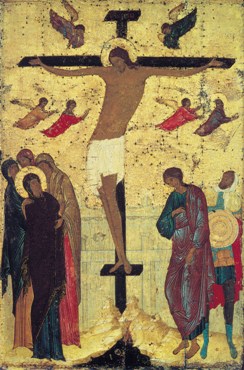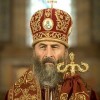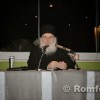Good Friday Morning
 ACCORDING TO THE HEBREW custom, the “Royal Hours,” four in number, are read at this time. These services consist of hymns, psalms, and readings from the Old and New Testaments, all related prophetically and ethically to the Person of Christ. In some churches the “Hours” are read in the afternoon, before the Vesper services.
ACCORDING TO THE HEBREW custom, the “Royal Hours,” four in number, are read at this time. These services consist of hymns, psalms, and readings from the Old and New Testaments, all related prophetically and ethically to the Person of Christ. In some churches the “Hours” are read in the afternoon, before the Vesper services.
THE VESPERS OF FRIDAY afternoon are a continuation of the Royal Hours. During this service, the removal of the Body of Christ from the Cross is commemorated with a sense of mourning for the terrible events which took place. Once more, excerpts from the Old Testament are read together with hymns, and again the entire story is related, followed by the removal from the Cross and the wrapping of the Body of Christ with a white sheet as did Joseph of Arimathea. Apostle Paul, interpreting the dreadful event, exhorts the Church: “For the word of the cross is folly to those who are perishing, but to us who are being saved it is the power of God . . . we preach Christ crucified . . . the power of God and the wisdom of God” (1 Cor. 1:18).
As the priest reads the Gospel, and taking the body, Joseph wrapped it in a white cloth,” he removes the Body of Christ from the Cross, wraps It in a white cloth and takes It to the altar. The priest then chants a mourning hymn: “When Joseph of Arimathea took Thee, the life of all, down from the Tree dead, he buried Thee with myrrh and fine linen . . . rejoicing. Glory to Thy humiliation, O Master, who clothest Thyself with light as it were with a garment.” The priest then carries the cloth on which the Body of Christ is painted or embroidered around the church before placing It inside the Sepulcher, a carved bier which symbolizes the Tomb of Christ. We are reminded that during Christ’s entombment He descends into Hades to free the dead of the ages before His Incarnation.
The Gospel readings which relate these events are: Matt. 27:1-38; Lk. 23:29-43; Matt. 27:29-54; John 19:31-37; Matt. 27:55-61. Good Friday is the only day in the year on which the Divine Liturgy is not officiated.
Today the devoted Christian ponders in his heart the deep meaning of the Seven Last Words of Christ uttered on the Cross, the first Divine Pulpit of Christianity.
Good Friday Evening: The Lamentation
THIS LAMENTATION SERVICE is the Orthros of Saturday morning, sung in anticipation Friday evening. It consists of psalms, hymns and readings, dealing with the death of Christ, in contrast to His divinity, and in expectation of His Resurrection. One of the hymns relates: “He who holds all things is raised up on the Cross and all creation laments to see Him hang naked on the Tree.” The thoughtful, and well-written Odes, sung by the choir, compare the Compassion of God and the cruelty of man; the Might of God and the moral weakness of man. The Odes picture all Creation trembling when witnessing its Creator hung by His own creatures: “Creation was moved . . . with intense astonishment when it beheld Thee hung in Golgotha.” The Odes remind us of the vision of Isaiah, who saw Christ, “the unwaning light of the manifestation,” and cried aloud, “The dead indeed shall arise and all those on earth shall rejoice.” During this service the Body of Christ is carried in procession around the church. In some parishes the entire flower-bedecked Sepulcher, symbolizing the Tomb, is carried in the procession.
The entire congregation joins in singing the, three parts of the “Hymns of Praise” (there are approximately 300 hymns, but only a few are sung). After these hymns are sung, the priest sprinkles the Sepulcher and the whole congregation with fragrant water. There is a simultaneous praise of both the Crucifixion and Resurrection of Christ with their purpose of the redemption of man. We no longer lament the sufferings of the Crucified One; we now lament chiefly for our own sins because we are far from God. So these services should have a rather personal meaning of repentance and of strong faith in God.
Christians observe Good Friday with fasting, prayer, cleanliness, self-examination, confession and good works, in humility and, repentance so that the Grace of the Cross might descend upon them.
The Gospel reading is Matthew 27:62-66.
















